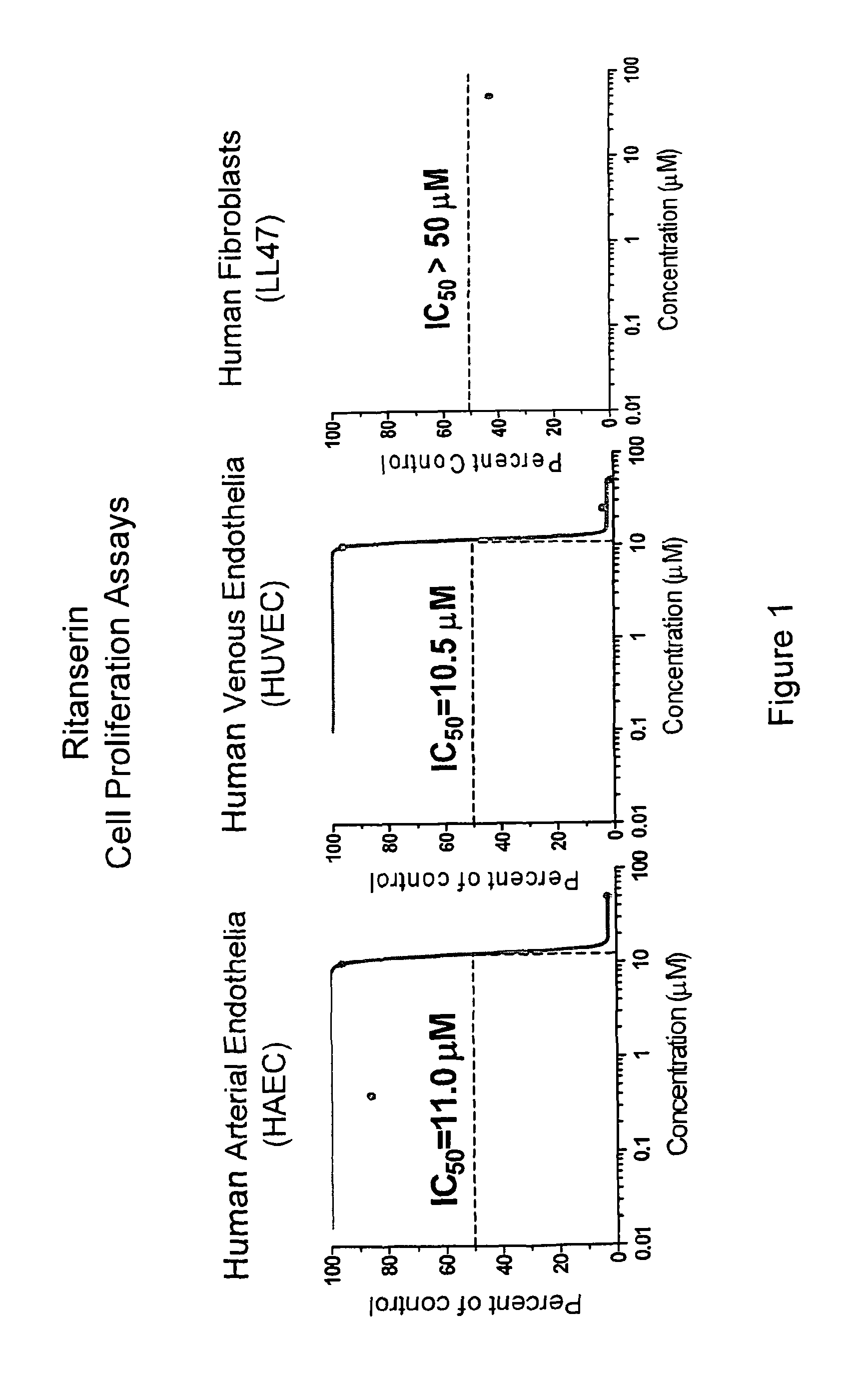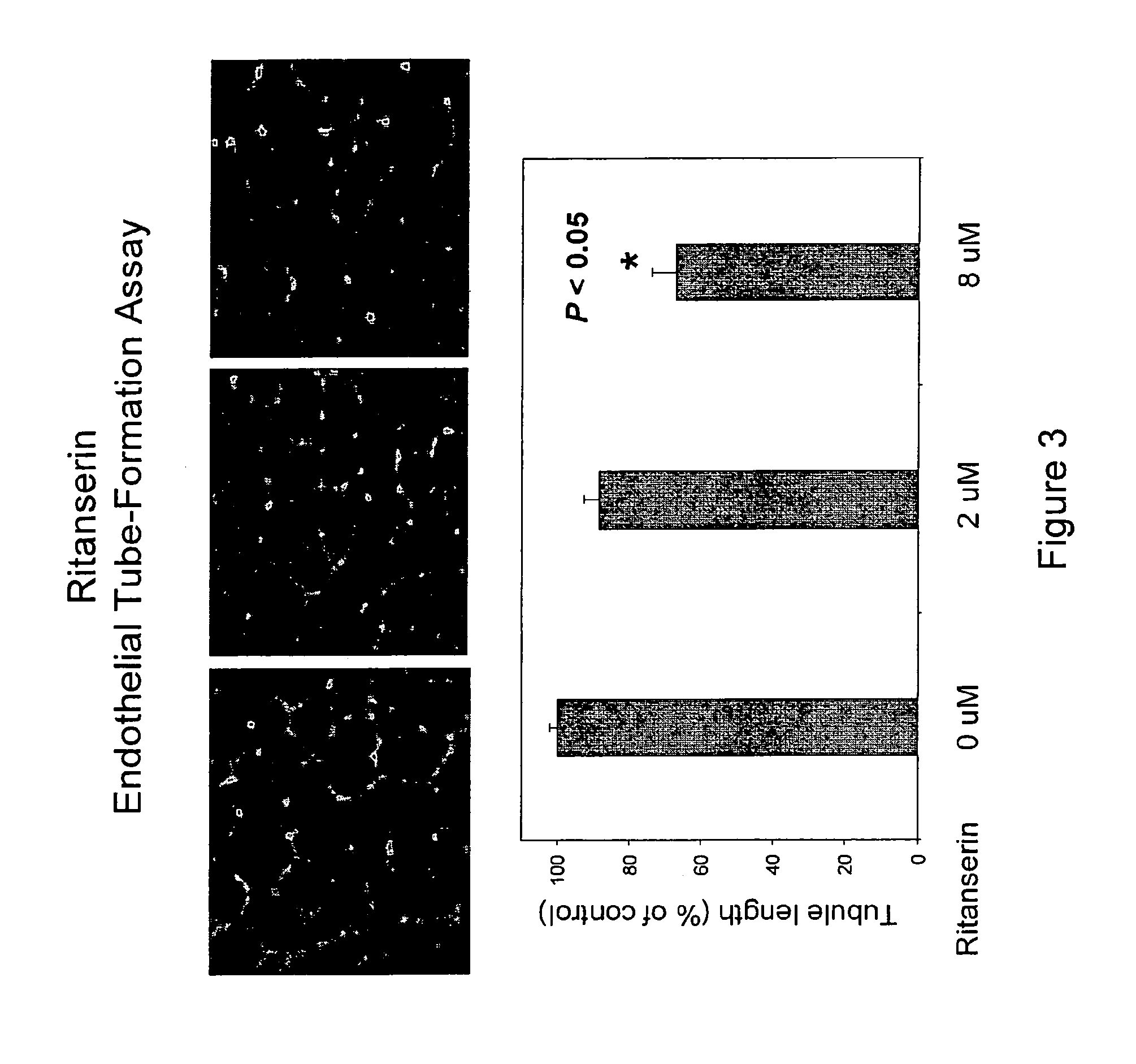Method of using biothionol and biothionol-like compounds as anti-angiogenic agents
a technology of biothionol and antiangiogenic agent, which is applied in the field of treating or preventing diseases associated with angiogenesis, can solve problems such as limited success to da
- Summary
- Abstract
- Description
- Claims
- Application Information
AI Technical Summary
Benefits of technology
Problems solved by technology
Method used
Image
Examples
example 1
[0216]Human primary cell lines, arterial endothelia, such as HAEC and HPAEC, venous endothelia HUVEC (from Cambrex BioScience Rockland Inc.), and lung fibroblasts LL47 (from the American Type Culture Collection) are cultured by following the instruction and used to evaluate the target compounds for their differential activity against human endothelia verses fibroblasts by CellTiter-Glo Luminescent Cell viability Assay. This assay, generating luminescent signals, is based on quantification of ATP levels in cell cultures. Amount of ATP produced in cell culture reflects the number of viable cells. Hence, this assay is often used to estimate cell proliferation and cytotoxic effects of test compounds. Cells are seeded in 96-well plates with their growth medium, about 5×103 cell per well. After 24 hours, various doses of the target compounds are added to the cultures, having four replicates for each dose. After 72 hours of treatment, CellTiter-Glo reagent is added ...
example 2
Endothelial Cell Migration Assay
[0217]Endothelial cell migration is a key step of the angiogenesis process, which is crucial for on-site recruitment of blood vessel formation. The trans-well filter / inserts chamber of Biocoat Endothelial Cell Migration Angiogenesis System (BD Biosciences) is used for endothelial cell migration assay, which is a 24-Transwell chamber plate containing 3-μm pore size inserts coated with human fibronectin. The inserts are incubated at 37° C. with 0.1% bovine serum albumin containing endothelial cell basal medium for 1 hour. Endothelial cells (HUVEC) are starved with 0.1% bovine serum albumin in endothelial cell basal medium for 4 to 5 hours before the cell harvest and then seeded (1×105 per well) in upper chambers of the Transwell plate with various treatments in 100 ul of 0.1% bovine serum albumin in endothelial cell basal medium. The full growth medium that contains various chemoattractants is added in the lower chambers. The cells are allowed to migrat...
example 3
Endothelial Tube Formation Assay
[0218]Human endothelial cells are cultured in vitro on extracellular matrix, which stimulates the attachment and differentiation of endothelial cells into tubules. The endothelial tube formation assay is based on this phenomenon. Endothelial cells (HUVEC) are seeded (1.5×104 per well) in a 96-well plates coated with extracellular matrix and treated with the target compounds at different concentrations with the full growth medium in triplicate. The cells are allowed to form endothelial tubes at 37° C. for about 18 hours and photographed under an inverted light microscope. The tubule lengths are quantified using image analysis software, Image-Pro Plus (Media Cybernetics, Inc., Silver Spring, Md.). Data are expressed as average tube lengths of three view fields for each well and triplicate wells for each treatment condition. IC50 values are calculated based on the dose curve.
PUM
 Login to View More
Login to View More Abstract
Description
Claims
Application Information
 Login to View More
Login to View More - R&D
- Intellectual Property
- Life Sciences
- Materials
- Tech Scout
- Unparalleled Data Quality
- Higher Quality Content
- 60% Fewer Hallucinations
Browse by: Latest US Patents, China's latest patents, Technical Efficacy Thesaurus, Application Domain, Technology Topic, Popular Technical Reports.
© 2025 PatSnap. All rights reserved.Legal|Privacy policy|Modern Slavery Act Transparency Statement|Sitemap|About US| Contact US: help@patsnap.com



